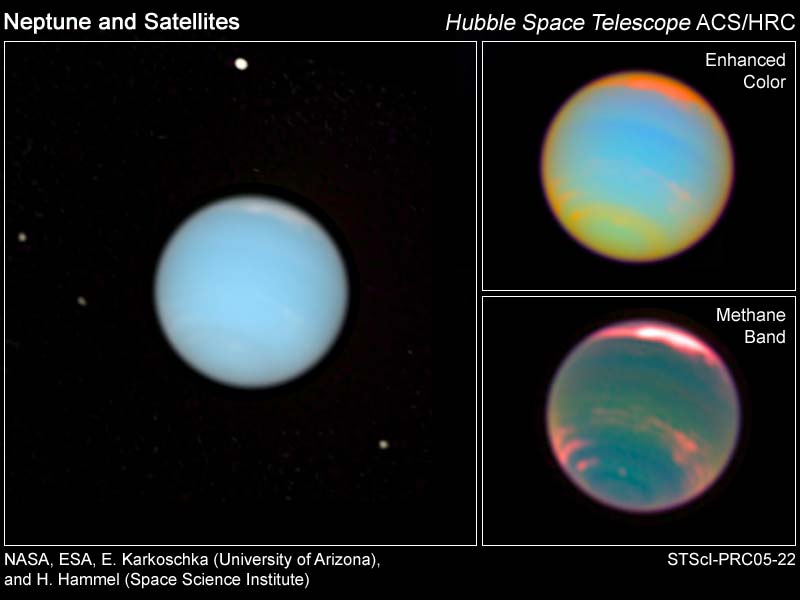

12:45 PM (EST), September 1, 2005
Release No.: STScI-2005-22
Hubble Makes Movie of Neptune's Dynamic Atmosphere:
NASA's Hubble Space Telescope captures the distant blue-green world, Neptune, and its satellites in this portrait. Astronomers used Hubble's assortment of filters to pinpoint high altitude clouds floating above the methane rich atmosphere. The icy moons seen in this view are Proteus (the brightest), Larissa, Despina, and Galatea. Neptune had 13 moons at last count. In Roman mythology, Larsissa and Despina were Neptunes's daughters.
New NASA Hubble Space Telescope images of the distant planet Neptune show a dynamic atmosphere
and capture the fleeting orbits of its satellites.
The images have been assembled into a time-lapse movie revealing the orbital motion of the satellites.
Images were taken in 14 different colored filters probing various altitudes in Neptune's deep atmosphere so that scientists can study the haze and clouds in detail.
These are several snapshots from the Neptune movie.
The natural-color view of Neptune (to the left), common to naked eye telescopic views by amateur astronomers, reveals a cyan colored planet. Methane gas in Neptune's atmosphere absorbs most of the red sunlight hitting the planet, making it look blue-green. The image was created by combining images in red, green, and blue light.
Neptune's subtle features are more visible in the enhanced-color view (top right). Images taken in special methane filters show details not visible to the human eye (bottom right). The features seen in this enhanced image must be above most of the sunlight-absorbing methane to be detectable through these special filters.
The planet is so dark at the methane wavelengths that long exposures can be taken, revealing some of Neptune's smaller moons. Clockwise from the top (in composite image at left), these moons are Proteus (the brightest), Larissa, Despina, and Galatea. Neptune had 13 moons at last count.
Neptune is the most distant giant planet in our Solar System, orbiting the Sun every 165 years. It is so large that nearly 60 Earths could fit inside it. A day on Neptune is between 14 hours and 19 hours. The inner two thirds of Neptune is composed of a mixture of molten rock, water, liquid ammonia and methane. The outer third is a mixture of heated gases comprised of hydrogen, helium, water and methane.
On April 29 and 30, 2005, Hubble images were taken every 4-5 hours, spaced at about a quarter of Neptune's rotational period. These where combined to create a time-lapse movie of the dynamic planet.
Credit: NASA, ESA,
E. Karkoschka (University of Arizona), and H.B. Hammel (Space Science Institute, Boulder, Colorado)
For additional information, please contact:
Ray Villard, Space Telescope Science Institute, Baltimore, Md. 21218, (e-mail) villard@stsci.edu, or
Lori Stiles, University Communications, University of Arizona, Tucson, Az. 85721, (e-mail) lstiles@u.arizona.edu
The Hubble Space Telescope is a project of international cooperation between NASA and the European Space Agency.
The Space Telescope Science Institute in Baltimore conducts Hubble science operations.
The Institute is operated for NASA by the Association of Universities for Research in Astronomy, Inc., Washington,
under contract with Goddard.
Other images, video, captions and press-release texts are available in the World-Wide Web, at http://hubblesite.org/newscenter/newsdesk/archive/releases/2005/22/.
For more information from the Hubble Space Telescope, link to the Space Telescope Science Institute Home Page.
![]() Updated: November 1 '05
Updated: November 1 '05
Best seen with MS Internet Explorer.
Back: ARVAL - Image Gallery (Hubble Makes Movie of Neptune's Dynamic Atmosphere)
Messages: